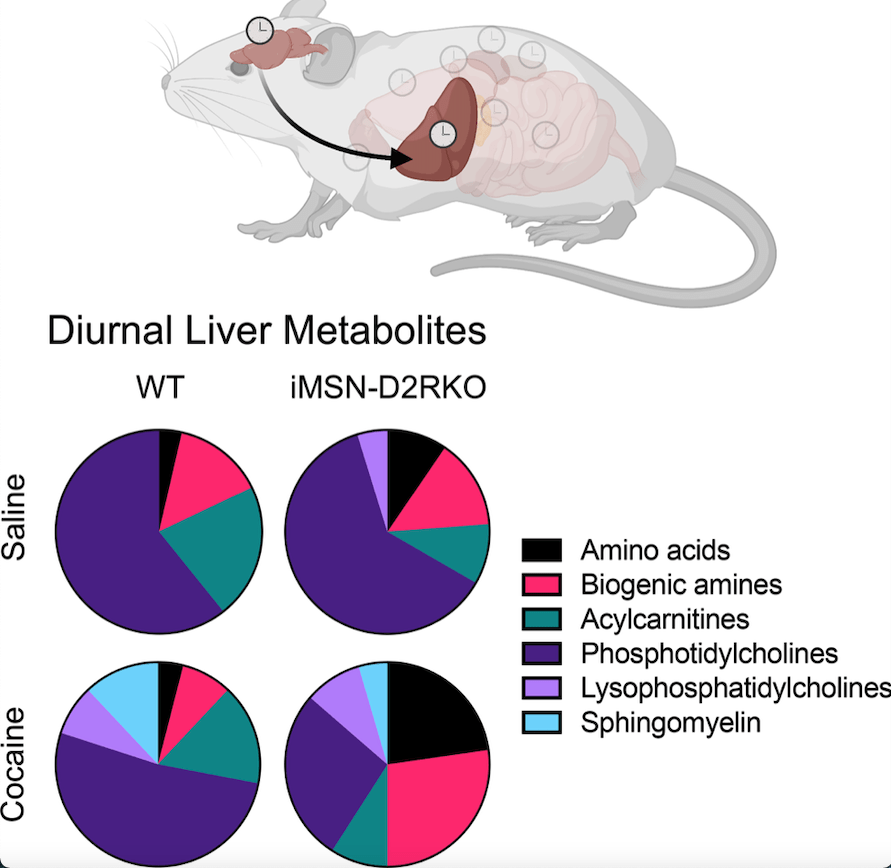New UCI-led study finds links between circadian rhythms, metabolism and addiction
Findings reveal possible role for peripheral organs in substance use disorders

Irvine, Calif., March 11, 2022 — A new University of California, Irvine-led study establishes important conceptual connections between the fields of circadian rhythms, metabolism, and addiction. Going beyond current studies on substance use disorders, which focus on the impact of addictive drugs on the brain, this new research highlights an existing connection between specific neurons and peripheral organs.
The study, titled “Dopamine D2 receptor signaling in the brain modulates circadian liver metabolomic profiles,” was published today in the Proceedings of the National Academy of Sciences.
“Our findings provide a link to substance use disorders and metabolic dysfunctions,” explained Emiliana Borrelli, PhD, professor of Microbiology & Molecular Genetics at UCI School of Medicine who, for this study, collaborated with the late Paolo Sassone-Corsi, PhD, professor of Biological Chemistry at UCI. “Through our research we explored how the disruption of normal neuronal functions affects metabolic activity and may move the body to an altered state away from homeostasis, which could contribute to the drug seeking behaviors exhibited by people with substance use disorders.”
By analyzing the liver metabolome of mice deficient in the expression of the dopamine D2 receptor (D2R) in striatal medium spiny neurons, the researchers found profound changes in the liver circadian metabolome compared to control mice. In addition, they found that activation of dopaminergic circuits by acute cocaine administration reprograms the circadian liver metabolome.
“D2R signaling in medium spiny neurons is key for striatal output and is essential for regulating the first response to the cellular and rewarding effects of cocaine,” said Borrelli. “Thus, our results suggest that changes in dopamine signaling in specific striatal neurons evoke major changes in liver physiology. Dysregulation of liver metabolism could contribute to an altered allostatic state and therefore be involved in continued use of drugs.”
The circadian clock is tightly intertwined with metabolism and relies heavily on multifaceted interactions between organ systems to maintain proper timing. Genetic and/or environmental causes can disrupt communication between organs and alter rhythmic activities. Substance use leads to altered dopamine signaling followed by reprogramming of circadian gene expression and metabolism in the reward system.
This study shows that dopamine D2 receptors (D2R) in striatal medium spiny neurons (MSNs) play a key role in regulating diurnal liver metabolic activities. In addition, drugs that increase dopamine levels, such as cocaine, disrupt circadian metabolic profiles in the liver, which is exacerbated by loss of D2R signaling in MSNs. These results uncover a strict communication between neurons/brain areas and liver metabolism as well as the association between substance use and systemic deficits,” said Borrelli.
Substance use disorders affect millions of people worldwide. The rewarding properties of substances, such as alcohol, nicotine, opioids, and psychostimulants, are linked to their ability to increase dopamine levels in brain areas that control emotions and induce pleasure. Drug intake modifies neuronal plasticity and is at the start of the process of addiction, which leads vulnerable individuals to continually seek and abuse these substances despite the adverse consequences on their lives.
This study was funded by grants from the National Institutes of Health under Award Number DA035600 and by the French Institut National de la Sante et de la Recherche Medicale (INSERM).
Future studies will examine whether the alterations in the specific metabolites identified in this study contribute to susceptibility to drug use.
About UCI’s Brilliant Future campaign: Publicly launched on October 4, 2019, the Brilliant Future campaign aims to raise awareness and support for UCI. By engaging 75,000 alumni and garnering $2 billion in philanthropic investment, UCI seeks to reach new heights of excellence in student success, health and wellness, research and more. The School of Medicine plays a vital role in the success of the campaign. Learn more by visiting https://brilliantfuture.uci.edu/uci-school-of-medicine/.
About the University of California, Irvine: Founded in 1965, UCI is the youngest member of the prestigious Association of American Universities and is ranked among the nation’s top 10 public universities by U.S. News & World Report. The campus has produced five Nobel laureates and is known for its academic achievement, premier research, innovation and anteater mascot. Led by Chancellor Howard Gillman, UCI has more than 36,000 students and offers 224 degree programs. It’s located in one of the world’s safest and most economically vibrant communities and is Orange County’s largest employer, contributing $7 billion annually to the local economy and $8 billion statewide. For more on UCI, visit www.uci.edu.
Media access: Radio programs/stations may, for a fee, use an on-campus ISDN line to interview UCI faculty and experts, subject to availability and university approval. For more UCI news, visit news.uci.edu. Additional resources for journalists may be found at communications.uci.edu/for-journalists.

